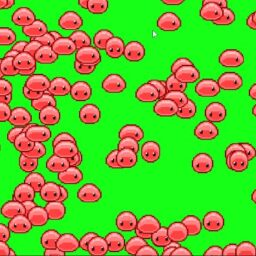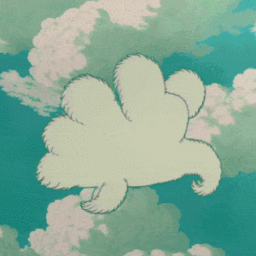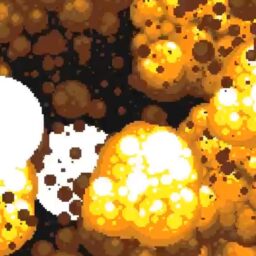simple starfield simulation combined with spritesheet animation This sketch refers to a custom creates spritesheet animation system for Processing – …
simple starfield simulation combined with spritesheet animation
This sketch refers to a custom creates spritesheet animation system for Processing – check more details here: https://turboflip.de/advanced-animation-with-spritesheets-in-processing/
It combines a simple starfield simulation with a 2D mouse click behaviour and spritesheet animation. all wrapped with object and class logic 🙂
// NOTE!!! this script needs to have a explosion.png spritesheet in the data folder!!!
int how_many_stars = 800;
float displace_amount = 0;
float targetSpeed = 0;
float main_speed = 0;
aSTAR[] allSTARS;
void setup() {
size(640, 480);
init_spritesheet();
imageMode(CENTER);
noSmooth();
// create a new list/array of explosion objects
allSTARS = new aSTAR[how_many_stars];
// run through the empty list an create a new star object at a random position and random phase
for (int i=0; i<allSTARS.length; i++) {
allSTARS[i] = new aSTAR(
random(-width/2, width/2),
random(-height/2, height/2)
);
}
}
void draw() {
displace_amount = map(mouseY, 0, height, 0, 4);
targetSpeed = map(mouseX, 0, width, 0, 2);
// update Speed
main_speed = lerp(targetSpeed, main_speed, 0.1);
noStroke();
fill(0, 44);
rect(0, 0, width, height);
translate(width/2, height/2);
// run through the star list and update each star object
for (int i=0; i<allSTARS.length; i++) {
if(allSTARS[i].do_explode){
allSTARS[i].explodeMe();
}else{
allSTARS[i].updateMe();
}
}
}
void mousePressed() {
// by pressing any mouse button, a random star needs to explode!
int nid = return_ID_of_the_nearest_star_2D();
allSTARS[nid].do_explode = true;
}
int return_ID_of_the_nearest_star_2D() {
float def_dist = 100000;
int rid = -1;
float cdist = 0;
for (int i=0; i<allSTARS.length; i++) {
cdist = dist( mouseX-width/2, mouseY-height/2, allSTARS[i].sx, allSTARS[i].sy);
if (cdist < def_dist) {
rid = i;
def_dist = cdist;
}
}
return rid;
}
// ---------------------------------------------
// ---------------------------------------------
// ----- SPRITESHEET OPERATIONS ----------------
// ---------------------------------------------
// ---------------------------------------------
// this spritesheet has only one row of 12 x 96x96px graphics
int[] explo_anim = {0,1,2,3,4,5,6,7,8,9,10,11 };
int DIM_X = 12; // horizontal dimension of spritesheet
int DIM_Y = 1; // vertical dimension of spritesheet
PImage main_sheet;
PImage[] sprites = new PImage[DIM_X*DIM_Y];
int animtick = 0;
// ---------------------------------------------
void init_spritesheet() {
imageMode(CENTER);
main_sheet = loadImage("explosion.png");
int W = main_sheet.width/DIM_X;
int H = main_sheet.height/DIM_Y;
for (int i=0; i<sprites.length; i++) {
int x = i%DIM_X*W;
int y = 0; // this is a hakc here! needs to be improved!!!
sprites[i] = main_sheet.get(x, y, W, H);
}
println("extracted " + sprites.length + "frames with each" + W + "x" + H + "px from spritesheet");
}
// ---------------------------------------------
int animate(float _x, float _y, int _w, int _h, int[] _arr, int _anim_tick, int _anim_speed, boolean _hor_flipped, boolean looped) {
pushMatrix();
translate(_x, _y);
if(_hor_flipped){
scale(1,1);
}else{
scale(-1,1);
}
image(sprites[_arr[_anim_tick]],0,0 , _w, _h);
popMatrix();
if (frameCount % _anim_speed == 0) {
if (_anim_tick<_arr.length-1) {
_anim_tick++;
} else {
if( looped ){
_anim_tick = 0;
}
}
}
return _anim_tick;
}
class aSTAR {
// basic var we need for each star object
float x = 0;
float y = 0;
float z = 0;
float sx=0;
float sy=0;
int my_anim_tick = 0;
float myspeed = .1;
boolean do_explode = false;
aSTAR(float _x, float _y) {
// set an inital position
x = _x;
y= _y;
z = random(width/2);
}
void resetMe() {
x = random(-width/2, width/2);
y = random(-height/2, height/2);
z = random(width/2);
do_explode = false;
}
void updateMe() {
z -= myspeed + main_speed;
x += ( noise(z*.01, y*.01, millis()*.0001 )-.5 ) * displace_amount;
y += ( noise(x*.01, z*.01, millis()*.0001 )-.5 ) * displace_amount;
sx = map(x / z, 0, 1, 0, width/2);
sy = map(y / z, 0, 1, 0, height/2);
// I use the z value to increase the star size between a range from 0 to 16.
float r = map(z, 0, width/2, 10, 0);
fill(255, 255-1*z);
noStroke();
ellipse(sx, sy, r, r);
if (z<4) {
resetMe();
}
}
void explodeMe() {
// update routine for each explosion object
my_anim_tick = animate(
sx,
sy,
int(z*1.2), int(z*1.2),
explo_anim,
my_anim_tick,
5,
false,
true
);
if (my_anim_tick>explo_anim.length-2) {
resetMe();
}
}
}
is this fireflies or stars?
This sketch is a simple redesign of Daniel Shiffmans starfield simulation. It adds up with a displacement that can be contolled by the mouse
int how_many_stars = 800;
float displace_amount = 0;
float targetSpeed = 0;
float main_speed = 0;
aSTAR[] allSTARS;
void setup(){
size(640,480);
init_spritesheet();
imageMode(CENTER);
noSmooth();
// create a new list/array of explosion objects
allSTARS = new aSTAR[how_many_stars];
// run through the empty list an create a new star object at a random position and random phase
for(int i=0;i<allSTARS.length;i++){
allSTARS[i] = new aSTAR(
random(-width/2, width/2),
random(-height/2, height/2)
);
}
}
void draw(){
displace_amount = map(mouseY, 0, height, 0, 4);
targetSpeed = map(mouseX, 0, width, 0, 2);
// update Speed
main_speed = lerp(targetSpeed, main_speed, 0.1);
noStroke();
fill(0,44);
rect(0,0,width,height);
translate(width/2, height/2);
// run through the star list and update each star object
for(int i=0;i<allSTARS.length;i++){
allSTARS[i].updateMe();
}
}
class aSTAR{
// basic var we need for each star object
float x = 0;
float y = 0;
float z = 0;
// int my_anim_tick = 0;
float myspeed = .1;
aSTAR(float _x,float _y){
// set an inital position
x = _x;
y= _y;
z = random(width/2);
}
void resetMe(){
x = random(-width/2, width/2);
y = random(-height/2, height/2);
z = random(width/2);
}
void updateMe(){
z -= myspeed + main_speed;
x += ( noise(z*.01,y*.01, millis()*.0001 )-.5 ) * displace_amount;
y += ( noise(x*.01,z*.01, millis()*.0001 )-.5 ) * displace_amount;
float sx = map(x / z, 0, 1, 0, width/2);
float sy = map(y / z, 0, 1, 0, height/2);
// I use the z value to increase the star size between a range from 0 to 16.
float r = map(z, 0, width/2, 10, 0);
fill(255,255-1*z);
noStroke();
ellipse(sx, sy, r, r);
if(z<4){
resetMe();
}
/*
// update routine for each explosion object
my_anim_tick = animate(
x,
y,
300,300,
explo_anim,
my_anim_tick,
5,
false,
true
);
*/
}
}


